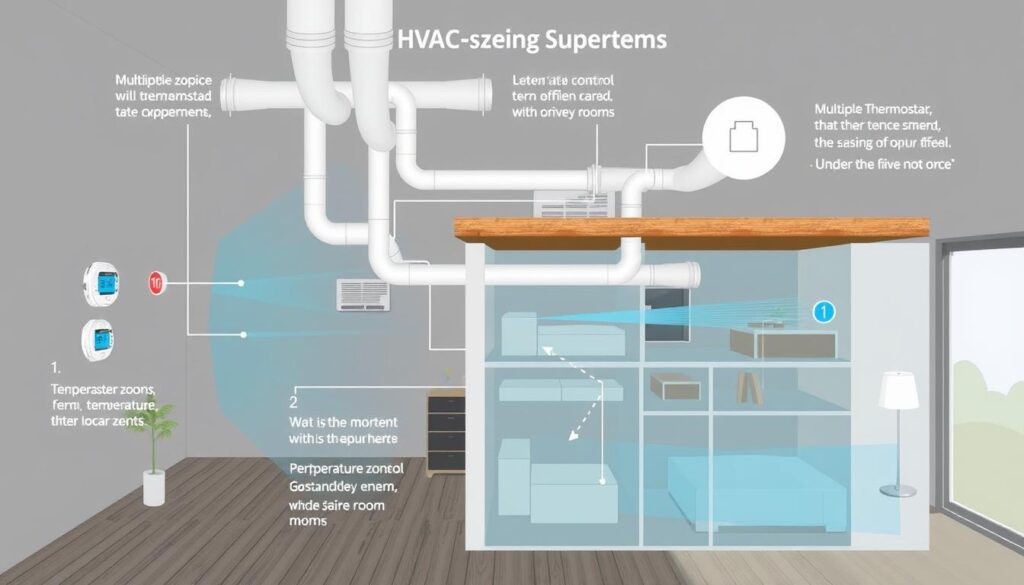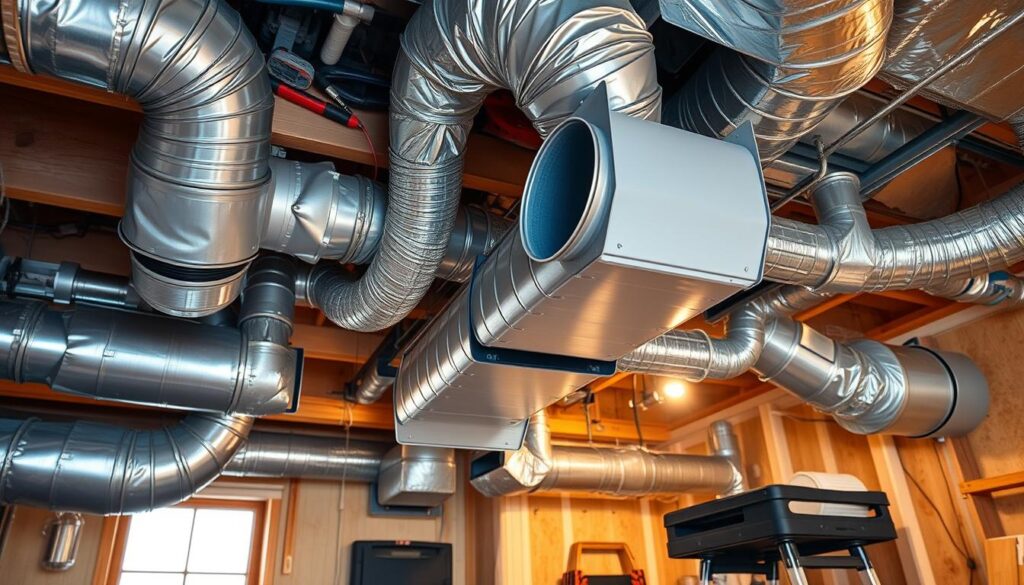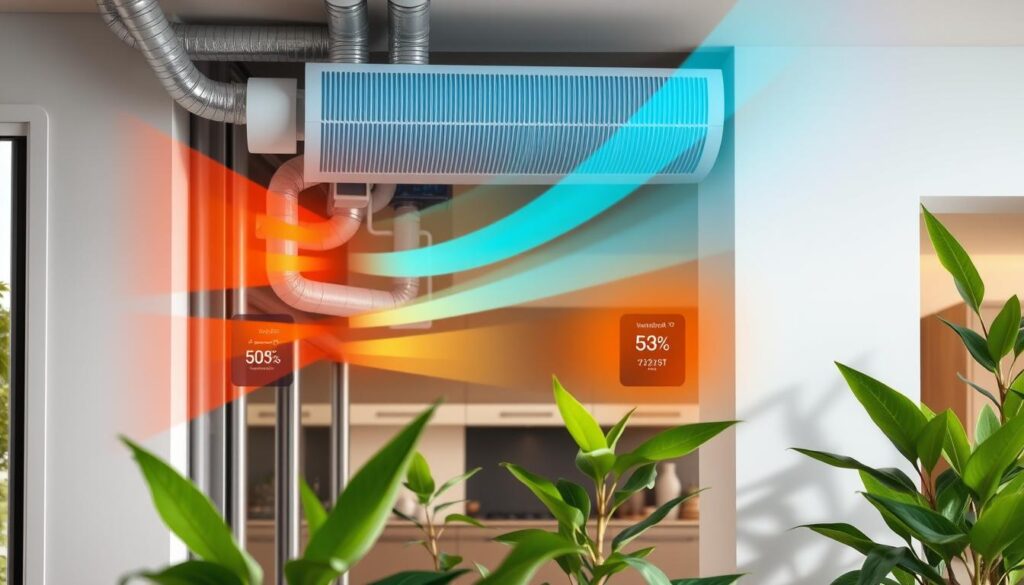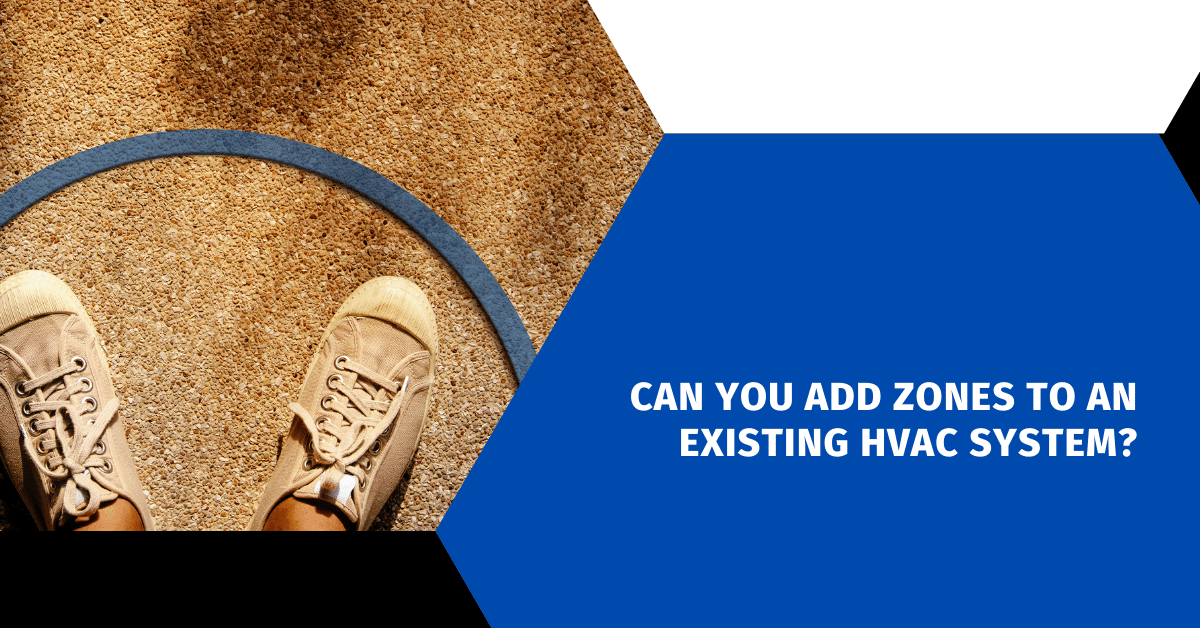Affiliate Disclosure
HVAC Guide Guys is a participant in the Amazon Services LLC Associates Program, an affiliate advertising program designed to provide a means for sites to earn advertising fees by advertising and linking to Amazon.
Can You Add Zones to an Existing HVAC System? Ever felt the temperature jump up as soon as you go upstairs on a hot day? This is called temperature stratification. It happens when a single-zone HVAC system can’t evenly spread air in a multi-level home. But, there’s a fix: HVAC zoning.

HVAC zoning has grown from simple room-by-room control to advanced central systems. Adding zones to your current HVAC system is a big step. It needs careful thought and sometimes new equipment. We’ll look into HVAC zoning, its benefits, challenges, and how to add it to your home.
Key Takeaways
- Upstairs temperatures can be 3 to 7 degrees warmer than downstairs in homes without zoning.
- Adding zones to a standard, single-stage HVAC system may reduce the efficiency of the evaporator coil.
- Variable-speed HVAC systems are better suited for zoning, as they can adjust airflow to meet the needs of each zone.
- HVAC zoning can enhance energy efficiency and provide precise temperature control in your home.
- Professional installation is recommended to ensure the proper integration of zoning components and maintain system performance.
Table of Contents
Understanding HVAC Zoning Systems
Single-zone HVAC and multi-zone HVAC systems have different ways to control your home’s temperature. A single-zone system heats and cools your whole house the same way. On the other hand, a multi-zone system lets you adjust the temperature in different areas or “zones” separately.
How HVAC Zoning Works
The heart of HVAC zoning is the dampers in the ductwork. These dampers control the airflow to each zone. This way, you can send heated or cooled air where it’s needed most. Each zone has its own thermostat, so you can set the temperature for that area.
Basic Components of Zoned Systems
- Dampers to control airflow to each zone
- Thermostats for individual temperature control in each zone
- A central control panel to manage the entire zoning system
With these parts, zoned HVAC systems offer a more efficient and flexible way to keep your home comfortable.
“A well-designed zoning system can lead to significant energy savings and improved indoor comfort.”
HVAC zoning lets you heat or cool only the parts of your home that are being used. This reduces the work your system has to do and can lower your energy bills over time.
The Evolution of HVAC Zoning Technology
Advances in HVAC technology have changed how we control heating, ventilation, and air conditioning. HVAC zoning has moved from a single-zone system to a more advanced solution. This change brings better temperature control and energy savings.
In the early days, HVAC zoning used simple manual dampers and thermostats. These allowed room-by-room temperature adjustments but were not very efficient. With new technology, we now have variable-speed equipment, smart thermostats, and advanced control systems. These have greatly improved our indoor comfort and energy use.
Today, modern zoning systems work well with HVAC units. They let us control temperature, humidity, and airflow in different areas. This not only makes our spaces more comfortable but also saves energy by only heating or cooling what’s needed.
The growth of HVAC zoning technology comes from a drive for innovation. Companies like Arzel Zoning have been at the forefront for over 40 years. They offer solutions that improve comfort and save money for both homes and businesses.
“Arzel Zoning’s unique air-driven dampers require no maintenance, providing a convenient and efficient solution for retrofitting homes and light commercial buildings without the need for extensive ductwork modifications.”
The future of HVAC zoning looks bright. With new sensor tech, machine learning, and smart home systems, we can expect even more improvements. The possibilities for HVAC technology and modern zoning systems are vast.
Explore Our HVAC Shop
Looking for top-rated HVAC tools, parts, and accessories? Visit our shop and find the perfect solution for your needs.
Visit the ShopBenefits of Adding Zones to Your HVAC System
Adding zones to your HVAC system brings many benefits. It makes your home more comfortable, efficient, and saves money. You can control the temperature in different areas of your home.
Enhanced Temperature Control
One big advantage of HVAC zoning is the ability to adjust temperatures for different areas. This means each room can be just the right temperature. No more cold spots or overheated areas.
With individual thermostats, you can set the perfect temperature for your family. It’s all about finding the comfort level that works best for you.
Energy Efficiency Improvements
Zoned HVAC systems use less energy because they only heat or cool the areas you’re using. This can save up to 30% on energy costs. It’s good for your wallet and the planet.
Cost Savings Over Time
Zoned HVAC systems save money in the long run. They help lower your utility bills and last longer. This means you won’t have to replace your system as often, saving you money.
| Benefit | Description |
|---|---|
| Temperature Customization | Ability to set individual temperatures for different zones, ensuring optimal comfort in each area. |
| Energy Efficiency | Reduced energy consumption and utility bills by targeting heating and cooling to occupied zones. |
| Cost Savings | Lower operating costs and extended system lifespan, providing long-term financial benefits. |
“Zoning technology has revolutionized the way we manage indoor climate, empowering homeowners to create tailored, energy-efficient environments that prioritize comfort and cost savings.”
Explore Our HVAC Shop
Looking for top-rated HVAC tools, parts, and accessories? Visit our shop and find the perfect solution for your needs.
Visit the ShopCan You Add Zones to an Existing HVAC System?
Adding zones to an existing HVAC system is possible but not always the best choice. The success of this depends on your current HVAC equipment.
Variable-speed HVAC systems work well for zoning. They adjust airflow to meet each zone’s needs, ensuring comfort everywhere in your home.
However, adding zones to a single-stage system can lower energy efficiency and shorten its life. This is because the system has to work harder to meet the new zone demands.
| Criteria | Variable-Speed Systems | Traditional Single-Stage Systems |
|---|---|---|
| Zoning Compatibility | Highly compatible | Compatibility issues |
| Energy Efficiency | Maintains high efficiency | Potential efficiency drops |
| System Longevity | Longer service life | Increased strain, shorter lifespan |
If you’re thinking about retrofitting HVAC or zoning existing systems, talk to a qualified HVAC expert. They can check your system, suggest the best zoning option, and ensure a smooth installation.
The cost to add zones to your HVAC system can be between $1,700 and $4,500, as HomeGuide states. But, the long-term savings and comfort make it worth it. The U.S. Department of Energy says zoning can cut energy costs by up to 30%.
Choosing to add zones to your HVAC system should be a thoughtful decision. Consider your home’s needs, your current equipment, and get advice from a skilled HVAC professional.
Variable Speed vs. Traditional HVAC Systems
Homeowners have a choice between variable-speed and traditional HVAC systems. Both provide heating and cooling, but they differ in performance and zoning compatibility.
Performance Differences
Variable-speed HVAC systems adjust their output to match the heating or cooling demand. This makes them more efficient, saving energy and offering better temperature control. Traditional single-stage systems, however, run at a fixed capacity. This can cause temperature swings and the need for bypass ducts in zoned setups.
Compatibility with Zoning
Zoning systems allow for independent temperature control in different home areas, saving energy. Variable-speed systems work well with zoning, adjusting output for each zone’s needs. Single-stage systems might need extra parts like dampers and bypass ducts. This can affect system efficiency.
“Zoning can provide localized temperature adjustments, preventing the need to heat or cool the entire house evenly.”
When upgrading your HVAC or installing a zoning system, consider variable-speed technology. It offers better performance and zoning compatibility. Homeowners can make a smart choice that meets their heating and cooling needs.
Explore Our HVAC Shop
Looking for top-rated HVAC tools, parts, and accessories? Visit our shop and find the perfect solution for your needs.
Visit the ShopInstalling Dampers in Existing Ductwork
Adding zones to an existing HVAC system often requires installing dampers in the ductwork. These dampers control airflow to different zones based on thermostat settings. This improves temperature control and energy efficiency. The number of dampers needed depends on how many zones you want to create.
While it might seem simple, professional installation is recommended. Improperly placed or sized dampers can cause airflow and system performance issues. HVAC technicians ensure the system is set up correctly.
Ductwork Modification and Damper Options
Arzel, a leading HVAC zoning equipment manufacturer, offers various damper options. Their EzySlide dampers come in round sizes from 4 to 16 inches and rectangular sizes from 4 to 48 inches. They also offer custom sizes, including oval shapes for oval ductwork.
The InsertaDamper is available in standard round sizes from 5 to 8 inches, with custom sizes up to 12 inches. The EzyFit dampers are in standard round sizes of 5, 6, and 7 inches, with a custom 8-inch option. For smaller ductwork, the RegiDamper is available in round sizes of 5, 6, and 7 inches.
Choosing the right dampers depends on ductwork dimensions, airflow needs, and desired zones. A professional HVAC contractor can help pick the best dampers for your home’s comfort and performance.
Pressure Management and Bypass Ducts
Installing dampers can increase static pressure in the ductwork, especially in single-stage HVAC systems. A bypass duct may be needed to handle excess air. However, bypass ducts can decrease evaporator coil efficiency and make the air handler work harder.
Choosing variable speed HVAC equipment can avoid the need for bypass ducts. These systems can adjust cooling or heating for each zone, reducing static pressure in the ductwork.

When adding zones, consider the system’s capacity and zone sizes. The smallest zone should be 30 to 35% of the compressor or heat pump’s capacity. This ensures optimal performance and comfort.
The Role of Bypass Ducts in System Zoning
Bypass ducts are key in managing static pressure when adding zones to an HVAC system. They redirect extra airflow back to the return plenum. This prevents over-pressurization that can happen when zones are closed off.
Pressure Management
In a zoned system, closing vents can cause airflow imbalance. This leads to higher static pressure. Bypass ducts solve this by letting excess air recirculate. This keeps air pressure balanced in the ductwork.
Research shows bypass ducts greatly improve system efficiency. When the bypass duct is closed, zoned systems can be 32% more efficient. This is compared to having the bypass duct open.
Installation Requirements
- The minimum airflow per ton is set at a minimum of 350 CFM/ton during system adjustments.
- HVAC experts recommend avoiding bypass ducts unless other options are not feasible, considering them as a last resort tool.
- Tailoring each system operation differently as per specific situation rather than standardizing adjustments.
- Expected excess air varies depending on the system configuration and number of zones calling.
- Systems are cycled through every possible combination of zones calling and staging while monitoring ESP to maintain at least 350 CFM/ton airflow.
- Extra weights may be required for adjusting an oversized bypass.
- Additional hours are often required during system startup to adjust the bypass and zones, beyond the initial installation time.
- Different adjustment requirements may arise if ductwork and bypass are undersized, including altering weight positions and minimum zone damper settings.
- Return visits for minor adjustments or customer re-education are common after initial system installation.
Proper installation and adjustment of the bypass duct are crucial for a zoned HVAC system’s efficiency and performance. It’s important to consider static pressure, airflow needs, and system setup. This ensures bypass ducts work well in system zoning.
Explore Our HVAC Shop
Looking for top-rated HVAC tools, parts, and accessories? Visit our shop and find the perfect solution for your needs.
Visit the ShopChallenges of Adding Zones to Standard Equipment
Adding zones to your HVAC system can be tricky, especially with standard single-stage equipment. You might face HVAC zoning challenges like higher static pressure, lower efficiency, and system overwork. These issues can shorten your equipment’s life and raise your energy bills.
Single-stage HVAC systems have a single-speed fan. This means they run at full speed or are off. This uneven cooling and higher energy use are big differences from variable-speed systems. Adding dampers and a bypass duct to create zones can make things worse. The extra air pressure can hurt system efficiency and wear down your equipment faster.
| Zoning with Single-Stage HVAC | Zoning with Variable-Speed HVAC |
|---|---|
|
|
Variable-speed HVAC systems are a better fit for zoning. They can adjust fan speed to meet each zone’s cooling needs. This avoids the need for a bypass duct and keeps system efficiency high. So, variable-speed systems are a better choice for adding zones to your HVAC setup.
Before diving into HVAC zoning, fix any air leaks or poor insulation. These problems can cause uneven heating and cooling. Fixing them can boost comfort and efficiency, possibly making a zoning system unnecessary.
Impact on System Efficiency and Performance
Adding a zoned HVAC system can greatly improve your heating and cooling setup. The effect depends on your equipment. Variable-speed systems usually stay efficient or get better with zoning. But, traditional single-stage systems might lose efficiency and wear out faster.
Energy Consumption Effects
Zoned HVAC systems can save a lot of energy. They only heat or cool the areas that are being used. This can cut your energy bills by 20% to 40%.
This happens because the system adjusts its output for each zone. It doesn’t have to work as hard as it would for the whole space.
System Longevity Considerations
Zoning can also affect how long your HVAC system lasts. It can save energy and reduce wear, but wrong installation or unbalanced airflow can shorten its life. To keep your system running well and lasting long, get it installed by pros and keep it maintained.

Knowing how zoning affects your HVAC system’s efficiency and performance helps you decide. A zoned system can save a lot of energy and make your space more comfortable. It’s a smart choice that can save you money for years.
Explore Our HVAC Shop
Looking for top-rated HVAC tools, parts, and accessories? Visit our shop and find the perfect solution for your needs.
Visit the ShopWhen to Consider HVAC Zoning
If you’re dealing with home comfort issues even after improving your home’s insulation, it might be time for an HVAC upgrade. Zoning systems are great for homes with different levels, varying sun exposure, or different temperature needs.
Zoning works best when you’re replacing your HVAC system, especially if you’re getting variable-speed equipment. Research shows zoning can cut energy costs by up to 30%.
With zoned HVAC systems, you can boost energy efficiency and control your home’s climate better. These systems let you set different temperatures in different areas. This ensures everyone in your home is comfortable.
| Benefits of HVAC Zoning | Potential Savings |
|---|---|
| Enhanced temperature control | Up to 30% reduction in utility bills |
| Improved energy efficiency | Substantial cost savings on monthly bills |
| Increased comfort levels | Gradual expansion of zoning capabilities |
When thinking about HVAC zoning, it’s crucial to get professional help. They’ll make sure your system is installed right. This way, you’ll get the best performance and efficiency.
Professional Installation Requirements
Installing an HVAC zoning system needs a pro’s touch. HVAC experts know how to set up these systems right. They consider things like zone size, damper placement, and ductwork changes.
HVAC professionals make sure your system works well. They size zones right, place dampers smartly, and adjust ducts if needed. They also set up control systems for easy temperature control in each zone.
Trying to install a zoning system yourself can cause problems. You might get uneven temperatures, waste energy, or damage the system. That’s why it’s best to let a HVAC professional do the job. They ensure your system works great, saving energy and keeping you comfortable.
“Proper HVAC zoning system installation is crucial for ensuring optimal performance and efficiency. Homeowners should always rely on the expertise of qualified professionals to ensure their investment is installed correctly.”
Want to know more about zoned HVAC systems? Or need a pro to talk to? Call ARS/Rescue Rooter at 866-399-2885 for a consultation.
Conclusion
Adding zones to your HVAC system can bring many benefits. You’ll get better temperature control, use less energy, and save money in the long run. But, you need to think about your home’s layout, current equipment, and what you find comfortable.
It’s possible to add zoning to old HVAC systems, but it’s not always easy. Adding new parts like dampers and thermostats can affect how well your system works. It’s important to talk to HVAC experts to find the best solution for your home.
Deciding to add HVAC zoning should be a careful choice. You need to weigh the benefits against your specific needs. With the help of skilled HVAC professionals, you can get a system that’s comfortable, saves energy, and lasts a long time.

